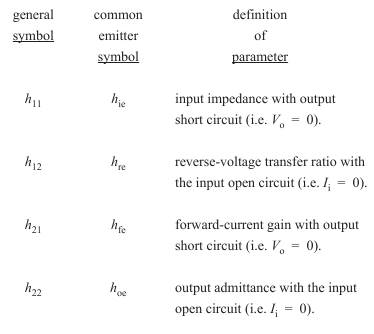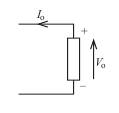THE h PARAMETER MODEL OF THE COMMON EMITTER CIRCUIT


Consider the equivalent circuit

The output is terminated on load RL, which has a value of 1 kΩ. Given the following h parameters, calculate the overall voltage gainfrom source to load (i.e. VL/VS).
hie = 1000Ω, hre = 2 ´ 10–4, hfe = 200, hoe = 10–4 S
Note that in this example VS = Vi and VL = Vo so that VL/VS = Vo/Vi.
The problem is essentially one of solving the pair of simultaneous equations

The snag is we have four unknowns. But Io can readily be expressed in terms
of Vo and RL.

Remember that the current Io is flowing into the circuit but, according to the
assumed polarity of Vo, the upper end of RL is shown as being positive.

In other words, the assumed directions of Io and Vo contradict each other. Hence the need for the minus sign. This is a point to watch in all circuits where assumptions
have arbitrarily been made about polarities and current directions.
Thus, Io = –Vo/1000 in our example, which enables a substitution for Io in the
output equation. To save a lot of messy algebra, the numerical values of the h
parameters can also be entered into the output equation.

So that

We can now substitute this into the input equation to eliminate Ii

which gives

the minus sign in the last equationmeans is that the output voltage is phase inverted with respect to the input voltage, which is a characteristic of the common emitter amplifier. This is illustrated graphically by the plot of Vo against Vi shown below.
